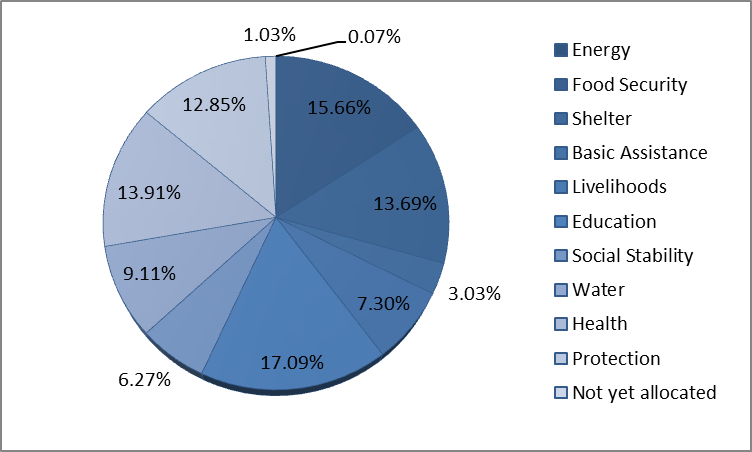As Lebanon continues to struggle with economic and financial meltdown, Covid pandemic and Port of Beirut explosion while hosting the highest number of displaced refugees per capita of any country, the aid landscape has changed considerably. Volume and composition of assistance altered with inflows from international donors targeting food security, agriculture, health, humanitarian and education.
According to USAID and 2021 Aid Tracking Lebanon data, total available funds for Lebanon by September 2021 including those disbursed by donors and 2020 carry over, as reported by implementing partners amounted for $1.69B split by $1.26B disbursed in 2021 and $430.9M carry over from 2020. The funds were distributed on several sectors as mentioned in the following graph.
Contributions to the Lebanon Crisis Response Plan in 2021 by sector:

Source: Q3 2021 Aid tracking Lebanon
The top 5 donor countries were USA, EU, Germany, Canada, and UK with United States of America grasping 40% and the European Union gripping 26% of the total aids inflows to Lebanon. Meanwhile, Canada’s share stood at 5% while UK and Norway each grasped 4%. In addition, Netherland, France, and Japan each contributed by 2% whereas Switzerland donated 1% out of the total aids to Lebanon by September 2021.
Overall, four allocated loans reported by donors as of September 2021 totaled $1.89B in budget. France and Italy allocated concessional loans with budgets of about $24.08M and $278.69M, respectively. In its turn, the World Bank also granted Lebanon 2 loans amounting to $819M and $776M. Noting that only $839.72M was disbursed till September 2021.
In more details, aid and contributions inflows to Lebanon were distributed through different lines and programs. As such, the UN released the 2021 Lebanon Emergency Response Plan (ERP) requesting $383M to address the urgent humanitarian needs of 1.1 million vulnerable Lebanese nationals and migrants in the country.
Another program was also introduced due to the complex emergency situation of Lebanon, the Central Emergency Respond Fund (CERF) and Lebanon Humanitarian Fund (LHF) which allocated a total of $10 M to ensure the continuation of essential health care services and water systems affected by the ongoing fuel crisis. Moreover, LHF is a critical source of funding of $25.3M distributed through 4 allocations, 33 partners and 37 projects and supporting life-saving humanitarian needs among all population groups. 65% of funds and aid were targeting Lebanese population, 25% Syrian refugees, 6% divers migrants and only 4% were donated to the Palestinian refugees.
Furthermore, State/PRM partner of UNICEF facilitated access to safe drinking water and sanitation services for more than 253,000 Syrians refugees and Lebanese host community members between April and July 2021.
Also, USAID/BHA partner of World Food Program (WFP) provided food assistance to 1.7 million people across Lebanon as economic and food security conditions deteriorated.
United States Government Humanitarian Funding For Lebanon as per September 2021:
![]()
![]()
Source: U.S. Agency for International Development (usaid.gov)
Undoubtedly, the crisis’s persistent negative impact on the Lebanese people and residents makes international aid and private investments as both essential for Lebanon’s recovery. However, building a better Lebanon is beyond international funds and it urgently requires decisive action particularly on reforms in the immediate and medium term.
In the current term, Lebanon must adopt and implement a credible and comprehensive macro-financial strategy that includes: a debt restructuring program aimed to achieve the sustainability of debt over the upcoming period; broad restructuring of the financial sector ensuring its solvency; implementing monetary and fiscal policies towards stability of the exchange rate.
In the medium-term, Lebanon has to arrange for better institutions, good governance as well as physical reconstruction. Further, dealing with the lack of sufficient foreign exchange reserves is crucial given Lebanon’s state of insolvency. Without these steps, recovery and reconstruction would not be maintainable, and situation would continue to worsen regardless of the amount of aid received!